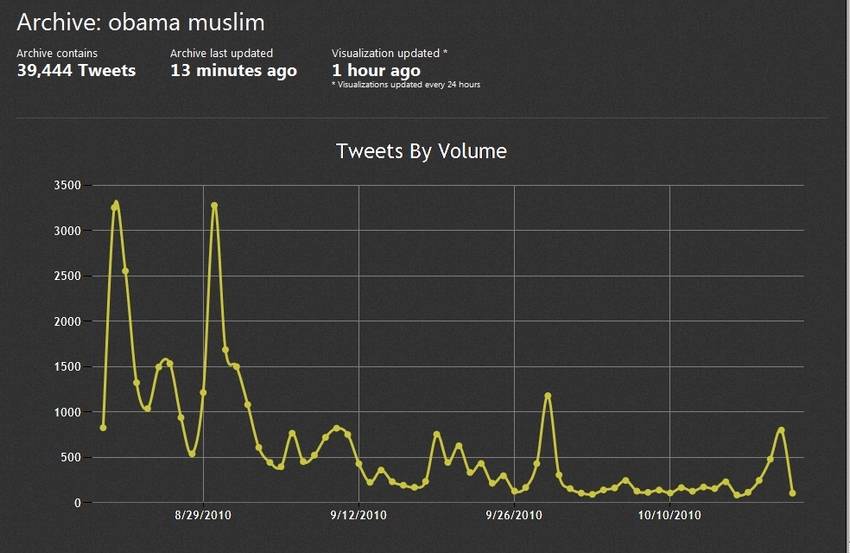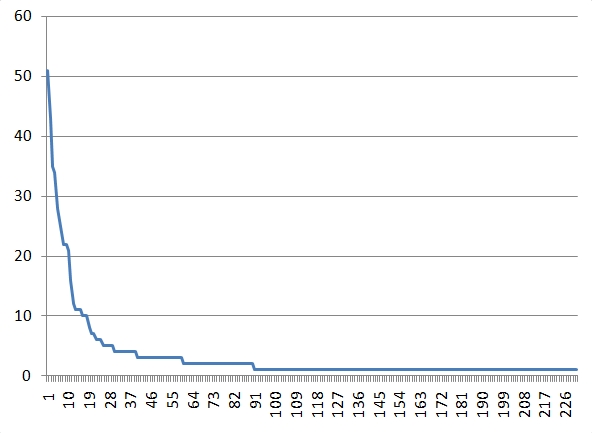
"Obama muslim" retweeting and more OR retweeting is just the start
The latest research finds that 6% of Twitter messages are retweets (Sysomos, Sept, 2010). In Audience: the reach of political messaging on Twitter and Politics Moves to Twitter: How Big is Big and Other Such Distributions I show that retweeting is much more prevalent in politics on Twitter. In most of the streams of messages about politics investigated the level of retweeting is between 20% and 50% of the messages. There is greater interaction in the political domain than is standard for all Twitter communiciation.
The next step is moving beyond the summary numbers to examine the process of retweeting and how that fits into the broader communication of any stream of messages. In this analysis I look at the retweeting in a stream of messaging identified by searching for "obama AND muslim." The search is being conducted using Archivist online, and summary information and the most recent tweets can be viewed at http://archivist.visitmix.com/bobboynton/24. The search began September 20, 2010, but the segment examined is October 18 through October 21.
 |
On the right hand side of the time line a 'bounce' is visible with tweets per day rising from 117 on the 18th to 802 on the 21st. The stream seemed to have arrived at a low level equilibrium beginning the first of October. The bounce suggests that some event or events moved the stream away from the equilibrium. I will analyze the tweets for the 18th through the first few hours of the 22nd. The total number of messages is 1989.
Of the 1989 messages 865, or 43.5%, were retweets. This high level of retweeting is consistent with other streams of political messages. It is also consistent with the retweeting in this stream; for the entire stream 42% of the messages were retweets. All of the 865 messages beginning with RT @ were examined and the repetitions were counted. There were 231 retweeted messages; the mean instances per message was 3.7. However, the mean is not a very helpful indication of the distribution.
 |
One of the messages was retweeted 51 times, another 43 times, but the number of retweets per message fell quickly to 1; 141 of the 231 messages were retweeted only once. A highly skewed distribution, like this, is quite often found in various counts of Twitter messages.
Retweeting is quoting with attribution. The form is RT @[original author] [quoted message]. But it is entirely possible to quote the original message without the authoral attribution. All you have to do is copy the original message and not precede it with RT @[original author]. And that is done frequently, though it has not been counted before to the best of my knowledge. To find all instances of a given message I examined the ten tweets that were repeated more than 20 times plus one other that was retweeted only 16 times, but it was the same message that had been retweeted more than 20 times referencing a different author. Then I searched for messages that were similar to the 11 tweets. The query by example routine of QDA Miner was used for this search.
The 11 tweets and the number of times retweeted are listed in the table.
1 |
RT @OTOOLEFAN: Same people who think Obama is a Muslim think Palin is a Christian. | 51 |
94 |
2 |
RT @iRevolt: The problem is not the accusation that "Obama is a Muslim" but the perverse fact that this is considered a reasonable 'slur' against someone | 43 |
50 |
3 |
RT @ChasLicc: Hey Mythbusters! While Obama's there, do you think you could bust that whole "Socialist, Kenyan, Muslim Antichrist" thing? Cheers. | 35 |
219 |
4 |
RT @ggreenwald: Leadership: MT @avinunu Obama won't visit revered Sikh temple in India b/c of fear head-cover will make him look Muslim http://post.ly/15gii | 34 |
|
5 |
RT @tunkuv: Obama's Sikh Joke http://bit.ly/b5C28f (My piece on his dropping the Golden Temple from his India itinerary, for fear of seeming Muslim) | 28 |
|
6 |
RT @madeupstats: Whilst 34% of Americans think Obama is a Muslim, 38% think that Nick Clegg is the British PM's same-sex partner. <<fools!!! | 26 |
32 |
7 |
RT @huffingtonpost: Obama may reportedly skip holy site to avoid appearing Muslim--he would have to wear a turban or skull cap http://huff.to/b6F0Zn | 24 |
|
8 |
RT @xenijardin: HAHAHAHA RT @seanbonner: Photo: Mythbusters take on the "Obama is a Muslim" thingy http://tumblr.com/xlwmadwcj | 22 |
|
9 |
RT @jtLOL: Obama's skipping a Sikh temple visit because wearing a hat that could be mistaken for Muslim garb makes him nervous.Over 2 u Juan | 22 |
|
10 |
RT @cdixon: WSJ series on online privacy are like Fox News stories on Obama being a muslim. Murdoch-ization I guess. | 21 |
27 |
11 |
RT @avinunu: Obama won't visit revered Sikh temple in India because he's afraid head-cover will make him look Muslim http://post.ly/15gii #Islamophobia | 16 |
|
| 4, 5, 7, 9, 11 | 124 |
561 |
The first is a message with an edge: "Same people who think Obama is a Muslim think Palin is a Christian." It was the most frequently retweeted message during the 4 days with 51 retweets, and was attributed to @OTOOLEFAN. Obama's projected visit to Mythbusters brought two tweets -- numbers 3 and 8 with 35 and 22 retweets. For the 10th message "Fox News stories on Obama being a muslim" is used as a reference to suggest how bad a WSJ series was. And there are four ways to comment on Obama deciding to skip a visit to a Sikh temple when he visits India: numbers 4, 5, 7, 9, and 11 with 34 and 28 and 24 and 22 and 16 retweets. The total for these four messages is 124.
Retweeting is just the start -- sometimes. The second column of numbers is the number of messages similar to the retweeted messages. The number includes both the retweets and similar messages that do not include authoral attribution. There is very little difference in the two numbers for retweets 2 and 6 and 10; the increase beyond the original retweets is quite modest. But there is a much larger difference for the first and third retweets and for the four that make the same point about Obama's trip to India. In these cases retweeting is just the start of the communication, and simply counting retweets gives a very partial view of the communication.
The number of retweets is taken as an indication of the connectedness of the messages. This stream, like many other streams about politics, is considerably more connected than standard. The difference is 6% to 43.5%. But if the question is about the connectedness of the messages then the number of retweets gives only the lower bound. In this case the number of retweets was 865. If you add all of the messages that were like the most frequently retweeted messages the number grows to 1,526, and that is 76.7% of all the messages. There were 231 individual messages that were retweeted. Those 231 messages became 1,526 when you take into account the retweeting of them and the messages that were similar though they were not exact copies. The analysis shows how to trace from individual messages to retweets and then to similar messages, and that is a more nuanced analysis and shows much more connection than simply counting retweets.
© G. R. Boynton
October 23, 2010